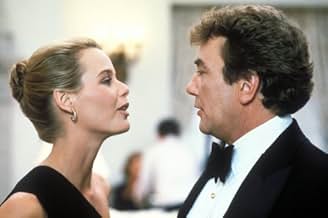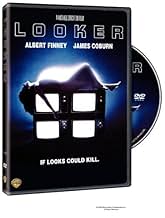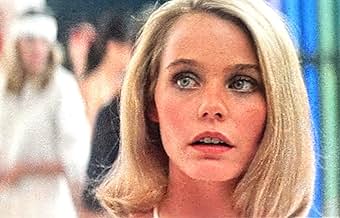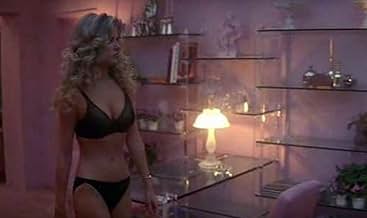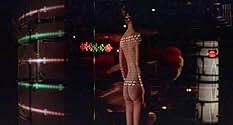अपनी भाषा में प्लॉट जोड़ेंThree of four models, who had plastic surgery done by Larry after a computed list, are dead. Neither the cops nor Larry believe they're suicides. Larry investigates and stays with the fourth... सभी पढ़ेंThree of four models, who had plastic surgery done by Larry after a computed list, are dead. Neither the cops nor Larry believe they're suicides. Larry investigates and stays with the fourth model. Who's behind the lists and murders?Three of four models, who had plastic surgery done by Larry after a computed list, are dead. Neither the cops nor Larry believe they're suicides. Larry investigates and stays with the fourth model. Who's behind the lists and murders?
- पुरस्कार
- 1 जीत और कुल 1 नामांकन
- Senator Robert Harrison
- (as Michael Gainsborough)
- Ellen
- (as Donna Benz)
- Technician in Scanning Room
- (as Terrence McNally)
फ़ीचर्ड समीक्षाएं
Finney and Coburn are subtly superb in their roles, while Crichton (unintentionally) satirizes a media-saturated culture ripe for the string-pulling. Barry De Vorzon's score is hauntingly impressive (and sadly, unavailable in soundtrack form) as is the cheesy 80's title track performed by Sue Saad (later covered by Kim Carnes on her "Voyeur" album).
People have slammed the script for its lack of explanation... however, a 15-minute scene depicting a rather detailed "summing up" of the plot was deleted from the theatrical/home video cut, but did make the film's network TV airings. With or without the scene, the film is an often-overlooked gem I would strongly recommend to anyone in the mood for a slick, sci-fi thriller.
Personally, I think it's both.
Much like Crichton's Westworld, the movie depends heavily on the computer arts to fill in for substance, and like Westworld, it succeeds. Looker is a pleasant and exciting little period piece, a time capsule for what science and advertising might be heading toward in the not too distant future.
To be fair to yourself, you must forgive the creaky performances by Finney, Dey, and Coburn (plus everyone else). It's the combination of guns, girls, and gadgets that keep the story moving (Crichton gets your attention at the very start by introducing a television lovely asking plastic surgeon Finney to alter her in strangely precise details; then you get the pre-surgery mugshots of the girl with her supposed imperfections--and what imperfections!--in full view). It's cheap and creepy, but everyone in the theater was hooked instantly by the looker on screen.
Don't look too closely, though. The plot holes are big and numerous, so thinking is not recommended. It's the flash-attachments-on-steroids that cause catatonia and the computer mapping of Susan Dey, standing there with her imperfections exposed, that keep you interested. It's strange--I've always liked Dey's looks and I'm not about to complain about seeing her in the all-together, but the bloodlessness of computers, their soul-less nature robs the scene of its prurient nature.
Crichton has hit upon something here. Computers make us so nervous, even a quarter century later, that the use of a story of cynical cyber-manipulation of consumers robs the viewer of getting his or her jollies out of seeing good-looking people nekked or in danger or both. In some ways it robs us of our interest in the human drama that movies depend on to be of lasting quality. It's a double edged sword, but it's both subtle and very effective.
In general, Looker isn't subtle, nor is it a wholly satisfying entertainment, but it does deserve a look.
Looker' is possibly director Michael Crichton's most criminally underrated film. Admittedly the screenplay often leaves a lot to be desired but the initial premise is both intriguing and fear-provoking. Crichton's script makes some rather fascinating, and in hindsight rather perceptive, comments about how corporations can abuse both the media and the general public simply through the use of television. Towards the end a particularly pertinent speech is made by John Reaston (James Coburn) on how the general public is willing to submit automatically to the enormous power that television possesses. However, much of the power that Looker' could have potentially possessed is lost with poor pacing, inappropriate and unrealistic dialogue and a couple of major plot-holes. In fact, some eminent questions remain unanswered and the movie ends on a sort of anti-climatic note.
Crichton's direction appears to be somewhat disjointed as the pace of the movie alternates constantly. To begin with Looker' has the correct proportion of suspense to action and is quite thrilling to behold. Unfortunately, certain scenes such as a car chase drag on and become somewhat tedious. One particular sequence of events towards the end of the movie drags on for fifteen minutes and while to begin with is compellingly suspenseful, the sequence begins to feel old and certainly spoils what could have been an effective ending. Looker' also suffers from some particular bland performances, particularly from central actor Albert Finney. His performance was predominantly lacklustre and featured uninspired sequences in which Finney would avoid gunfire by unenthusiastically throwing himself across the floor. That being said Finney did seem to fit the role of Larry Roberts and was fairly entertaining to watch. Susan Dey and James Coburn were both enjoyable in their respective roles and one wonders why more was not done with their characters. Had more time been spent trying to develop these characters then maybe something more could have been done with the movie.
Surprisingly, despite all its flaws Looker' is still somewhat compelling. It is certainly not Crichton's best film but is still vastly underrated in my opinion. The opening sequence is suspenseful and intriguing which is occasionally echoed throughout the rest of the movie, though unfortunately not enough. Looker' is blessed with some wickedly delightful black humour, particularly towards the end and a bizarre, yet mesmerizing, electric musical score from Barry de Vorzon. Some fans will be happy to know that there are unnecessary scenes of full frontal nudity, including one from Susan Dey. The humorous overtones of that particular scene undoubtedly shine through. The ideas of hypnotic and subliminal messaging are what make Looker' compelling even though the film is still heavily damaged by the lack of decent characterisation and storytelling. I think Looker' is worth watching but is most certainly not to everyone's taste. My rating for Looker' 6.5/10.
क्या आपको पता है
- ट्रिवियाThe first ever film to create 3D shading with a computer that produced the first ever CGI human character was the model Cindy (Susan Dey). This movie achieved this feat before Disney's more famous ट्रॉन (1982) hit the screens. The Web site Filmsite said of Cindy: "Her digitization was visualized by a computer-generated simulation of her body being scanned--notably the first use of shaded 3D CGI in a feature film. Polygonal models obtained by digitizing a human body were used to render the effects."
- गूफ़At the conference near the end, when Dr. Larry Roberts is disguised as a security guard, during several sequences getting in and out of elevators the wound on the side of his mouth disappears and reappears.
- भाव
Cindy Fairmont: Hi. I'm Cindy. I'm the perfect female type: 18 to 25. I'm here to sell for you.
- इसके अलावा अन्य वर्जनThe broadcast television version contains additional footage, including a scene where Reston (James Coburn) explains to Dr. Roberts (Albert Finney and Cindy ('Susan Dey') why Digital Matrix had the "perfect" models killed.
टॉप पसंद
- How long is Looker?Alexa द्वारा संचालित
विवरण
- रिलीज़ की तारीख़
- कंट्री ऑफ़ ओरिजिन
- भाषा
- इस रूप में भी जाना जाता है
- Kein Mord von der Stange
- फ़िल्माने की जगहें
- Art Center College of Design, पासडेना, कैलिफोर्निया, संयुक्त राज्य अमेरिका(Interiors and exteriors. As 'Digital Matrix Inc.' headquarters building.)
- उत्पादन कंपनियां
- IMDbPro पर और कंपनी क्रेडिट देखें
बॉक्स ऑफ़िस
- बजट
- $80,00,000(अनुमानित)
- चलने की अवधि1 घंटा 33 मिनट
- रंग
- ध्वनि मिश्रण
- पक्ष अनुपात
- 2.39 : 1
इस पेज में योगदान दें




